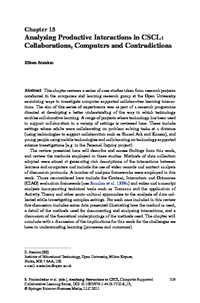Analyzing Productive Interactions in CSCL Collaborations, Computers and Contradictions
Eileen Scanlon
Zu finden in: Analyzing Interactions in CSCL (Seite 319 bis 339), 2010
 |
 |
 Diese Seite wurde seit 5 Jahren inhaltlich nicht mehr aktualisiert.
Unter Umständen ist sie nicht mehr aktuell.
Diese Seite wurde seit 5 Jahren inhaltlich nicht mehr aktualisiert.
Unter Umständen ist sie nicht mehr aktuell.
 Zusammenfassungen
Zusammenfassungen
 This chapter reviews a series of case studies taken from research projects conducted in the computers and learning research group at the Open University examining ways to investigate computer supported collaborative learning interactions. The aim of this series of experiments was as part of a research programme directed at developing a better understanding of the way in which technology enables collaborative learning. A range of projects where technology has been used to support collaboration in a variety of settings is reviewed here. These include settings where adults were collaborating on problem solving tasks at a distance (using technologies to support collaboration such as Shared Ark and Kansas), and young people using mobile technologies and collaborating on technology supported science investigations (e.g. in the Personal Inquiry project).
This chapter reviews a series of case studies taken from research projects conducted in the computers and learning research group at the Open University examining ways to investigate computer supported collaborative learning interactions. The aim of this series of experiments was as part of a research programme directed at developing a better understanding of the way in which technology enables collaborative learning. A range of projects where technology has been used to support collaboration in a variety of settings is reviewed here. These include settings where adults were collaborating on problem solving tasks at a distance (using technologies to support collaboration such as Shared Ark and Kansas), and young people using mobile technologies and collaborating on technology supported science investigations (e.g. in the Personal Inquiry project).The review presented here will describe and assess findings from this work, and review the methods employed in these studies. Methods of data collection adopted were aimed at generating rich descriptions of the interactions between learners and computers and include the use of video records and content analysis of discussion protocols. A number of analysis frameworks were employed in this work. Those reconsidered here include the Context, Interaction and Outcomes (CIAO) evaluation framework (see Scanlon et al. 1998a) and video and transcript analysis incorporating technical tools such as Transana and the application of Activity Theory and other socio-cultural approaches to the analysis of data collected while investigating complex settings. For each case included in this review this discussion includes some data presented illustrating how the method is used, a detail of the methods used for documenting and analyzing interactions, and a discussion of the theoretical underpinnings of the methods used. The chapter will conclude with a discussion of the implications for this work for the challenges we have in understanding learning (processes and outcomes).
 Dieses Kapitel erwähnt ...
Dieses Kapitel erwähnt ...
 Anderswo finden
Anderswo finden
 Volltext dieses Dokuments
Volltext dieses Dokuments
 |  Analyzing Productive Interactions in CSCL: Collaborations, Computers and Contradictions: Artikel als Volltext bei Springerlink ( Analyzing Productive Interactions in CSCL: Collaborations, Computers and Contradictions: Artikel als Volltext bei Springerlink ( : :  , 1954 kByte; , 1954 kByte;  : :  2020-11-28) 2020-11-28) |
 Anderswo suchen
Anderswo suchen 
 Beat und dieses Kapitel
Beat und dieses Kapitel
Beat hat Dieses Kapitel während seiner Zeit am Institut für Medien und Schule (IMS) ins Biblionetz aufgenommen. Beat besitzt kein physisches, aber ein digitales Exemplar. Eine digitale Version ist auf dem Internet verfügbar (s.o.). Aufgrund der wenigen Einträge im Biblionetz scheint er es nicht wirklich gelesen zu haben. Es gibt bisher auch nur wenige Objekte im Biblionetz, die dieses Werk zitieren.










 Lernen
Lernen
 Biblionetz-History
Biblionetz-History